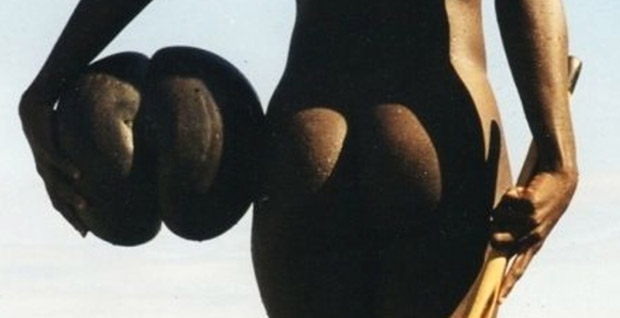
From the rear, a coco de mer seed is the fruit equivalent of a belfie. Frontally, it’s a life-size replica of a woman’s reproductive region, including thigh tops, an exposed belly, and a pudendal cleft. It even has a landing strip of pubes crowning the V. Other names for it include the lady fruit and the butt nut. Scientists use the taxonomic binomial Lodoicea maldivica. Whatever you call it, it’s the Kim Kardashian of the plant kingdom.
Beyond its ass-shaped nutshell, the coco de mer shares other commonalities with our anatomy (or at least that of porn stars). Not only is the male flower a huge brown phallic rod; the female blossoms are simulacra of DD+ breasts, each with its own nectarlactating nipple-like ovule. There’s a spermy white pudding inside the seed that hardens as the fruit ages. Its exterior green husk has the shape of a heart. The seed’s interior resembles kidneys. After a coco de mer falls to the ground, it sends out a freaky fingerlike umbilical cord from its vaginal orifice. These botanical butt cheeks grow only in the Seychelles, a tiny archipelago in the Indian Ocean. Before anyone knew the Seychelles existed, the fruit’s shell was periodically found floating in the sea like a wet dream, leading to speculation that it grew underwater (hence the name coco de mer, or coconut of the sea).
The shells remain luxury goods today. They can be legally purchased at official outlets in the Seychelles for a price between $200 and $1,000 per nut. The rate depends on the size and the appearance; like humans, no two are alike. Some are flat and supermodelsvelte; others are more Sir Mix-a-Lot–style, rounder and bigger-bottomed, with “much back.” The shells can also be bought illegally on the black market. Concerns that the fruit could become endangered have gotten it classified as an endangered species on the International Union for Conservation of Nature’s Red List. Fortunately, a serious preservation program is under way.
While working on my book about the world of fruits, The Fruit Hunters, I traveled to the Seychelles to learn more about the coco de mer and its callipygian qualities. Here’s what I discovered about the plant’s most humanoid traits.
THE FLOWERS
Coco de mer trees are either male or female. The male flower, called a catkin, looks like a dick, with some appearing more erect than others. When young, this phallic inflorescence is one or two feet long, orange-brown, and points stiffly upward. Pollen from these stamens fertilizes the hefty breast-like female flowers—which have a moist ovule positioned precisely where you’d expect the nipple to be. After pollination, the woody female breast-blossoms swell into bubblebutted fruits as the spent catkin wilts and sags, becoming increasingly dark and shriveled, until it falls to the forest floor with a dank, damp thud.
THE FRUITS
High on the branches of a coco de mer palm, the medicine-ball-size fruits look like big green hearts swaying overhead. At maturity, they fall to the ground and crack open upon impact. Within the heart-shaped box is the seed shell that so strangely resembles the female pelvic region. If left undisturbed, this seed becomes the beginning of a new tree. After it lands, an umbilical cord (cotyledon) starts to emerge from the fruit’s central slit. The germ of the baby plant is located in the cotelydon’s swollen tip. This cord slowly plunges into the earth and then travels up to 65 feet away. After burrowing in a spot where it won’t have to fight for root space with its parent, this heat-seeking embryonic cable gradually sprouts from the ground. The first leaves emerge, and pretty soon a bonerific new tree starts growing skyward.
THE FLESH
After pollination of the flower, it takes seven years for a fruit to mature. When very young, the nuts are yellowish and contain a semen-like liquid. A year or so later, at the peak of edibility, that goo gels into a thickened custard-like consistency. By the time the fruit drops, its jelly has congealed into a hard vegetable ivory, which can be extracted and blended into face-whitening creams or added to cough syrups. This ivory also has purported aphrodisiacal properties, a notion that the Seychellois historian and environmentalist Kantilal Jivan-Shah debunked when I interviewed him. “It’s all in the mind,” he scoffed. “The dried kernel irritates your bladder so you’ll have an erection.” Far more interesting, in terms of edibility, is a one-year-old fruit. Until the 1970s, distinguished visitors were sometimes honored with a taste of this translucent jelly, then known as the billionaire’s fruit because of its rarity. These days, you can’t legally purchase the fruit; the only noncriminal way to try it is to know someone with a tree in his backyard who is willing to share it with you. How does it taste? Some Seychellois residents swear it’s like mother’s milk, straight from the breast.
This article is featured in the January Issue of VICE.



